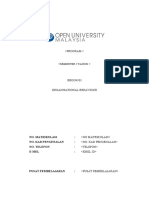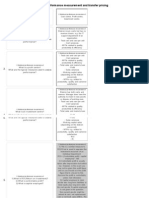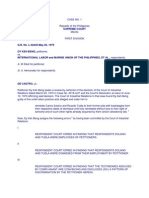0 ratings0% found this document useful (0 votes)
75 viewsTeam Building
Team Building
Uploaded by
Foto ShackThis document discusses team building and self-managing teams. It explains the meaning of team building, describes the team building process, and identifies team building skills. Some key team building skills include consultation, interpersonal skills, research, and feedback. The stages of team building are identified as identifying problems, collecting data, providing feedback, problem solving experiences, and applying lessons on the job. Self-managing teams are defined as being self-reliant groups given autonomy to control their own behaviors to produce good results.
Copyright:
© All Rights Reserved
Available Formats
Download as PPT, PDF, TXT or read online from Scribd
Team Building
Team Building
Uploaded by
Foto Shack0 ratings0% found this document useful (0 votes)
75 views13 pagesThis document discusses team building and self-managing teams. It explains the meaning of team building, describes the team building process, and identifies team building skills. Some key team building skills include consultation, interpersonal skills, research, and feedback. The stages of team building are identified as identifying problems, collecting data, providing feedback, problem solving experiences, and applying lessons on the job. Self-managing teams are defined as being self-reliant groups given autonomy to control their own behaviors to produce good results.
Original Description:
Team Building
Copyright
© © All Rights Reserved
Available Formats
PPT, PDF, TXT or read online from Scribd
Share this document
Did you find this document useful?
Is this content inappropriate?
This document discusses team building and self-managing teams. It explains the meaning of team building, describes the team building process, and identifies team building skills. Some key team building skills include consultation, interpersonal skills, research, and feedback. The stages of team building are identified as identifying problems, collecting data, providing feedback, problem solving experiences, and applying lessons on the job. Self-managing teams are defined as being self-reliant groups given autonomy to control their own behaviors to produce good results.
Copyright:
© All Rights Reserved
Available Formats
Download as PPT, PDF, TXT or read online from Scribd
Download as ppt, pdf, or txt
0 ratings0% found this document useful (0 votes)
75 views13 pagesTeam Building
Team Building
Uploaded by
Foto ShackThis document discusses team building and self-managing teams. It explains the meaning of team building, describes the team building process, and identifies team building skills. Some key team building skills include consultation, interpersonal skills, research, and feedback. The stages of team building are identified as identifying problems, collecting data, providing feedback, problem solving experiences, and applying lessons on the job. Self-managing teams are defined as being self-reliant groups given autonomy to control their own behaviors to produce good results.
Copyright:
© All Rights Reserved
Available Formats
Download as PPT, PDF, TXT or read online from Scribd
Download as ppt, pdf, or txt
You are on page 1of 13
OBJECTIVES
Explain the meaning of team building
Describe the process of team building
Identify the different team building skills
Discuss Self-Managing teams
TEAM BUILDING
activities intended to encourage
teamwork.
• Team members must work
together to be effective.
• Cooperation is needed among all
the teams that make up the whole
organization.
• Encourages team members to
examine how they work together.
Clues To Its Need
Interpersonal Disagreement over
conflicts among the teams purpose &
team members. tasks.
Negative climate
Low degree of
within the team
team morale or
cohesiveness Stagnation within the
team with members
Large influx of new resisting change &
members new ideas.
STAGES IN TEAM BUILDING
Identification of a
problem.
Collection of relevant
data
Data feedback &
confrontation
Problem solving
experience
On the job application
Skills Useful in Team Building
Consultation
Interpersonal
Research
Presentational
Process consultation
Feedback
Process Consultation
Set of activities that help others focus on what is
currently happening around them.
Help team members perceive, understand and
react constructively to current behavioral events.
Create independence in team members so that
they can more effectively think & act for
themselves
Process Consultation:
Facilitating Behavior Desired Effects on TM
Encouraging open Examine intended versus
communication actual roles
Observe team meeting Identify problems
Probing & questioning Examine consequences of
Confronting individual behavior
Stimulating problem React constructively to
solving current behavioral event
Attend non verbal cues Explore new alternatives
Encouraging learning Think & act independently
Feedback
Encourages members to understand how
they are seen by others within their team
and to take self-correcting action.
It helps the group meet to develop specific
plans of action for solving their
misunderstandings.
It serves as a springboard in improving
team’s activity.
Ethical Dilemmas within Teams
Team member
appraisals
Member assistance
Team selection
Team Perfection
Team Rewards
Self-Managing Teams
Self-reliant or self-directed teams - natural
work groups that are given substantial
autonomy & in return are asked to control
their own behavior to produce good result.
Multi-skilling - members flexibly float
from area to area and task to task,
depending on where they needed most.
Advantages of Self-Managing
Team
Improved Flexibility of
staff
More efficient operations
through the reduced
number of job
classifications
Lower absenteeism
Higher levels of job
satisfaction & commitment
Disadvantages of Self-Managing
Team
Extended time to
implement them
High training
investment
Early inefficiencies
due to job rotation
Inability of some
employees to adapt to
a team structure.
Thank You
You might also like
- Chap-1 - PDF Notes - Work Livelihood and CareerDocument21 pagesChap-1 - PDF Notes - Work Livelihood and CareerSafa SamreenNo ratings yet
- Managing TeamsDocument42 pagesManaging TeamsAudrey Cawis50% (2)
- Team BuildingDocument9 pagesTeam BuildingAmit Kr GuptaNo ratings yet
- Levelling Resources: Let Me Count The WaysDocument16 pagesLevelling Resources: Let Me Count The WaysWilldenNo ratings yet
- Common Project Problems: Spotting Showstoppers Before They Stop The Show!Document18 pagesCommon Project Problems: Spotting Showstoppers Before They Stop The Show!LuchoNo ratings yet
- PPT-presentation RRSDocument30 pagesPPT-presentation RRSM. Vadivel MURUGESANNo ratings yet
- New Appointees of Central Water Engineering Services: 30 December 2016 Nwa, PuneDocument36 pagesNew Appointees of Central Water Engineering Services: 30 December 2016 Nwa, Punerocky7sharma-89684No ratings yet
- A Review of Existing Pushover Methods For 2-D RC BuildingsDocument60 pagesA Review of Existing Pushover Methods For 2-D RC Buildingsrunkir0% (1)
- Application For Empanelment of Consultants 2017-18Document23 pagesApplication For Empanelment of Consultants 2017-18Priyanka GuptaNo ratings yet
- Structural Health MonitoringDocument31 pagesStructural Health MonitoringDiya lizbeth joseNo ratings yet
- RS577 - Civil Engineering Curriculum 2073Document90 pagesRS577 - Civil Engineering Curriculum 2073mahesh bhattaraiNo ratings yet
- Ashutosh Sama SoftwareDocument53 pagesAshutosh Sama SoftwareDalvirFoxtrotSinghNo ratings yet
- 201608-34-Plumbing Do's and Don'TsDocument2 pages201608-34-Plumbing Do's and Don'TsAbdulBariNo ratings yet
- Consultant Empanelment FormDocument24 pagesConsultant Empanelment Formshashikant gaurNo ratings yet
- CICM 2015 JAHER WASIM Full Paper Performance Based DesignDocument10 pagesCICM 2015 JAHER WASIM Full Paper Performance Based DesignTahseen AkhtarNo ratings yet
- Basics of Project Management: A Project Plan Can Be Considered To Have Five Key Characteristics That Have To Be ManagedDocument3 pagesBasics of Project Management: A Project Plan Can Be Considered To Have Five Key Characteristics That Have To Be ManagedJan BooysenNo ratings yet
- Presented by Manish SharmaDocument24 pagesPresented by Manish SharmaAtshayaNo ratings yet
- Rain Water HarvestingDocument17 pagesRain Water HarvestingJohn MathewNo ratings yet
- Gravity Dam 1Document69 pagesGravity Dam 1DHANUSHREE K CVE20ANo ratings yet
- Civil Engineering SoftwareDocument30 pagesCivil Engineering SoftwareGebre TensayNo ratings yet
- Leadership and Followership: A Presentation By: G. Aditya Kiran (09501) Gaurav S. Kudtarkar (09505)Document21 pagesLeadership and Followership: A Presentation By: G. Aditya Kiran (09501) Gaurav S. Kudtarkar (09505)gaurkud100% (1)
- 12e. Particular Specs (Plumbing)Document42 pages12e. Particular Specs (Plumbing)VISHAL SINGHNo ratings yet
- Performance-Based Design in Earthquake Engineering State of DevelopmentDocument7 pagesPerformance-Based Design in Earthquake Engineering State of DevelopmentMaryam KhorsandNo ratings yet
- Introduction .PPSXDocument29 pagesIntroduction .PPSXengsalamNo ratings yet
- Team BuildingDocument6 pagesTeam BuildingNard LastimosaNo ratings yet
- BridgeDocument27 pagesBridgeParth AnajwalaNo ratings yet
- Practical of Construction MaterialDocument39 pagesPractical of Construction MaterialLaxmi Narayan GurungNo ratings yet
- NFNMS 5Document87 pagesNFNMS 5wanpudinNo ratings yet
- Rain Water Harvesting: Gautam Banerjee UP Jal NigamDocument28 pagesRain Water Harvesting: Gautam Banerjee UP Jal NigamAniket Gurav100% (1)
- Cost of Quality: Dr.R.RAJU Professor Dept of Industrial Engg. Anna UniversityDocument24 pagesCost of Quality: Dr.R.RAJU Professor Dept of Industrial Engg. Anna UniversityJanaNo ratings yet
- Project LeadershipDocument121 pagesProject LeadershipjimmydomingojrNo ratings yet
- 9 Chapter 2f - Fresh ConcreteDocument21 pages9 Chapter 2f - Fresh ConcretetashaNo ratings yet
- Risk ManagementDocument22 pagesRisk Managementkirang gandhiNo ratings yet
- Team BuildingDocument29 pagesTeam BuildingNauman Arif WainceNo ratings yet
- History of Software EngineeringDocument15 pagesHistory of Software EngineeringMD AbdulMoid MukarramNo ratings yet
- ON StakeholderDocument8 pagesON StakeholderMohit PandyaNo ratings yet
- Team Building: by Abhinay RoyalDocument20 pagesTeam Building: by Abhinay Royalabhinayroyal143No ratings yet
- Lecture 4ADocument17 pagesLecture 4AFenta DejeneNo ratings yet
- Specification of RCC: Submitted To:-Prof R.J.Shah Submitted By: - Madhav Purohit 000RDMTCE1920007Document39 pagesSpecification of RCC: Submitted To:-Prof R.J.Shah Submitted By: - Madhav Purohit 000RDMTCE1920007Madhav PurohitNo ratings yet
- Sanitary Fixtures Fittings Appliances & Appurtenances 21 NovDocument61 pagesSanitary Fixtures Fittings Appliances & Appurtenances 21 NovTesfa GetachewNo ratings yet
- Bridge Inspections: Dan WalshDocument25 pagesBridge Inspections: Dan Walshdiarto trisnoyuwonoNo ratings yet
- Sonar Structural TrainingDocument14 pagesSonar Structural TrainingGiridhari ChandrabansiNo ratings yet
- Is 6041 1985 PDFDocument25 pagesIs 6041 1985 PDFBharath Reddy ChinthiReddy100% (1)
- SHM 2015 12 02Document137 pagesSHM 2015 12 02Sivaram KottaliNo ratings yet
- Building Utilities Steel Reinforcement Bars SpecificationsDocument28 pagesBuilding Utilities Steel Reinforcement Bars Specifications1004.100% (1)
- Composite Beams-I: ©teaching Resource in Design of Steel Structures - IIT Madras, SERC Madras, Anna Univ., INSDAGDocument38 pagesComposite Beams-I: ©teaching Resource in Design of Steel Structures - IIT Madras, SERC Madras, Anna Univ., INSDAGhemant_durgawaleNo ratings yet
- Leadership Development: AM Strategy PM ActivityDocument27 pagesLeadership Development: AM Strategy PM ActivitySalman MuttaqinNo ratings yet
- Final Combined Complete Empanelment Application For GurugramDocument164 pagesFinal Combined Complete Empanelment Application For Gurugramchetan singhNo ratings yet
- CONSTRUCTION SafetyDocument91 pagesCONSTRUCTION SafetyGobindaSahuNo ratings yet
- Lab Manual With 20 ExpDocument68 pagesLab Manual With 20 ExpGiridhari ChandrabansiNo ratings yet
- Performance-Based Design in Earthquake Engineering: State of DevelopmentDocument8 pagesPerformance-Based Design in Earthquake Engineering: State of Developmentcc ingenierosNo ratings yet
- Technical Note For ConstructionDocument44 pagesTechnical Note For ConstructionDanie RoyNo ratings yet
- Tructural Ealth Onitoring: M. Mayur S.I.E.T.K PutturDocument37 pagesTructural Ealth Onitoring: M. Mayur S.I.E.T.K PutturrashidkingNo ratings yet
- Risk Management in Public Sector: Presented By: Siti Fatimah Razak Presented For: Dr. Kalsom SallehDocument12 pagesRisk Management in Public Sector: Presented By: Siti Fatimah Razak Presented For: Dr. Kalsom SallehSiti FatimahNo ratings yet
- Planning, Design & Analysis of A Commercial Building With Flat Slab Considering Earthquake Induced Forces Using Etab'SDocument25 pagesPlanning, Design & Analysis of A Commercial Building With Flat Slab Considering Earthquake Induced Forces Using Etab'Ssumit100% (1)
- Presentation On Reinforcing Detailing of R.C.C MembersDocument15 pagesPresentation On Reinforcing Detailing of R.C.C Membersswapnil belsareNo ratings yet
- Teams and Team BuildingDocument18 pagesTeams and Team BuildingmustardbrilauvNo ratings yet
- Group 9Document32 pagesGroup 9Yda Nur ImanNo ratings yet
- Leading Self-Managed TeamsDocument25 pagesLeading Self-Managed TeamsMuhd AqibNo ratings yet
- Chapter7 GroupsDocument32 pagesChapter7 GroupsGoogle UserNo ratings yet
- Teamworka Key To Organizational SuccessDocument3 pagesTeamworka Key To Organizational SuccessazharmateNo ratings yet
- Planning Team MeetingDocument17 pagesPlanning Team MeetingFoto ShackNo ratings yet
- PIA Reports GraphDocument1 pagePIA Reports GraphFoto ShackNo ratings yet
- Icons: Cisco ProductsDocument13 pagesIcons: Cisco ProductsFoto ShackNo ratings yet
- Mindanao Island: MCT Is Connected To All Ports in MindanaoDocument4 pagesMindanao Island: MCT Is Connected To All Ports in MindanaoFoto ShackNo ratings yet
- Implementing Standardized Work Training and Auditing CompressDocument100 pagesImplementing Standardized Work Training and Auditing CompressWilberth Denilson Matos TuncarNo ratings yet
- Martocchio Sc10 PPT 06Document49 pagesMartocchio Sc10 PPT 06awis alqarniNo ratings yet
- Neo-Classical TheoryDocument5 pagesNeo-Classical TheoryMohammed AwolNo ratings yet
- No. Matrikulasi: No. Kad Pengenalan: No. Telefon: E-MelDocument14 pagesNo. Matrikulasi: No. Kad Pengenalan: No. Telefon: E-Melfarah najihahNo ratings yet
- 7 IJRAR2001818 Rahma Sri Wahyuni Dan SyamsirDocument6 pages7 IJRAR2001818 Rahma Sri Wahyuni Dan SyamsirRizal HaronNo ratings yet
- EcoPure Business PlanDocument28 pagesEcoPure Business PlanAyieNo ratings yet
- Leature IndustryDocument30 pagesLeature Industrydaman.arneja143No ratings yet
- ParcoDocument24 pagesParcoSami UrRahmanNo ratings yet
- Team 1 Final ProjectDocument74 pagesTeam 1 Final Projectapi-341265585No ratings yet
- Maintenance Planner Role ResponsibilitiesDocument2 pagesMaintenance Planner Role ResponsibilitiesAnonymous OuY6oAMggxNo ratings yet
- HR 2025Document20 pagesHR 2025multi lisensiNo ratings yet
- Accreditation Tool BlankDocument47 pagesAccreditation Tool BlankChristian ErrylNo ratings yet
- Ramboll Management ConsultingDocument16 pagesRamboll Management ConsultingConstantn AlexNo ratings yet
- ACCA F5: Chapter 13 - Divisional Performance Measurement and Transfer PricingDocument8 pagesACCA F5: Chapter 13 - Divisional Performance Measurement and Transfer PricingRajeshwar NagaisarNo ratings yet
- Briagas, Iris Jean M.Document7 pagesBriagas, Iris Jean M.IRIS JEAN BRIAGASNo ratings yet
- Unit 2 - Orgnaized and UnorganizedDocument6 pagesUnit 2 - Orgnaized and Unorganizedanushiya mNo ratings yet
- MOTOR InsuranceDocument95 pagesMOTOR InsuranceRajat ShuklaNo ratings yet
- Gr149758 Philex Gold Vs Philex BulawanDocument10 pagesGr149758 Philex Gold Vs Philex BulawanNesrene Emy LlenoNo ratings yet
- Advt 8 2011Document6 pagesAdvt 8 2011Biswa Jyoti GuptaNo ratings yet
- Labor Law Cases (1-8)Document38 pagesLabor Law Cases (1-8)Samael Morningstar100% (1)
- Education Vs TrainingDocument3 pagesEducation Vs TrainingMark Lyndon M OrogoNo ratings yet
- Job Application Form MOL PakistanDocument2 pagesJob Application Form MOL PakistanMuhammadUxairNo ratings yet
- Unit 9organizational Change and Change AgentsDocument14 pagesUnit 9organizational Change and Change Agentsurvipatel1191No ratings yet
- Soal PTS Semester Ganjil Bahasa Inggris XiiDocument2 pagesSoal PTS Semester Ganjil Bahasa Inggris XiierikchkNo ratings yet
- What Kind of Career Do You Want To Pursue in Future and WhyDocument6 pagesWhat Kind of Career Do You Want To Pursue in Future and WhymayankNo ratings yet
- Human Resources Management Policy TemplateDocument5 pagesHuman Resources Management Policy Templateparthshah302No ratings yet
- 388d4787-1007-4a9d-8000-6330b72130d5Document5 pages388d4787-1007-4a9d-8000-6330b72130d5hajdinNo ratings yet
- The Exact Science of MatrimonyDocument4 pagesThe Exact Science of MatrimonyVibol SanNo ratings yet
- MMM240 - Assignment 1Document8 pagesMMM240 - Assignment 1Anu DharmawardenaNo ratings yet





























































































